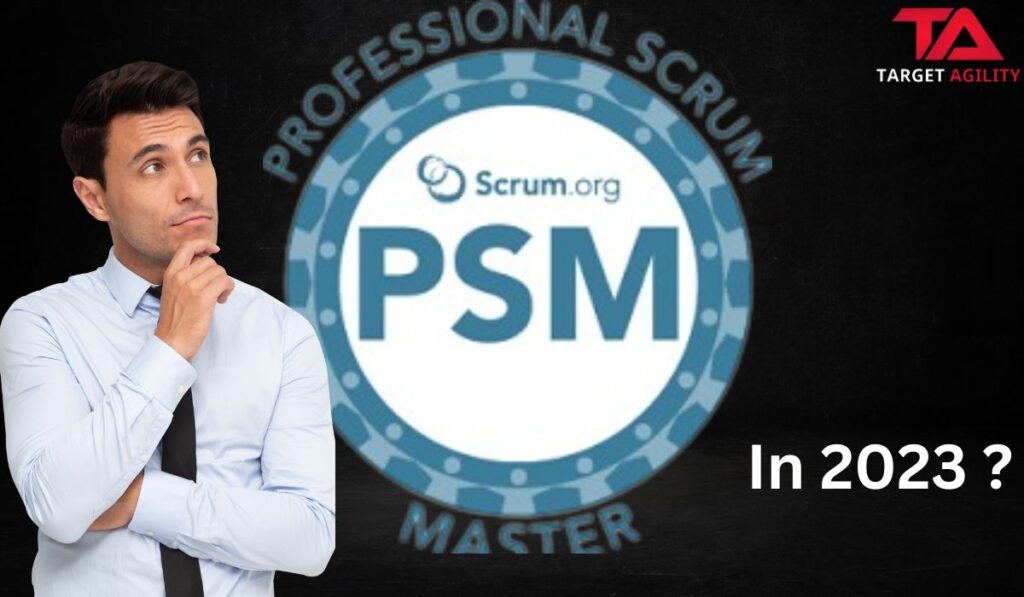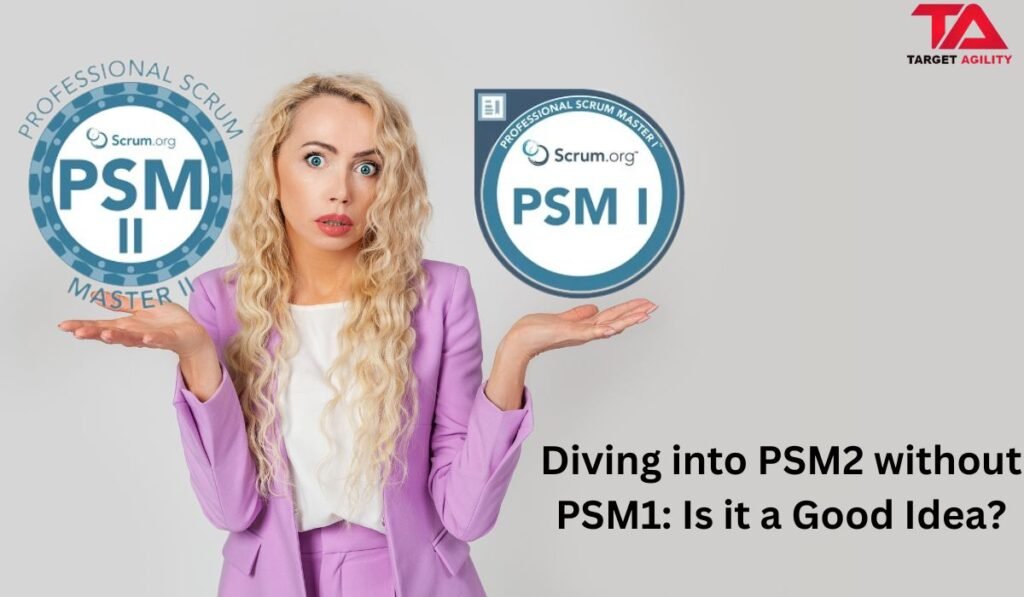Excelling in 2023: Why Getting PSM Certified Is a Big Deal

As we step into 2023, staying on top of the professional game is crucial. One surefire way to do this is by getting a Professional Scrum Master (PSM) certification. It’s a powerful tool that can give your career a significant boost, and in this blog, we’ll break down why. In the fast-paced world we live in, businesses are all about being quick and adaptable. PSM certification teaches you how to make teams more agile, and that’s a skill employers are looking for. With industries leaning towards agility, having a PSM certification puts you in sync with what the job market wants. PSM certification doesn’t just teach you about Scrum (the agile framework it’s based on); it also hones your project management skills. Scrum focuses on working in small, efficient steps and constant improvement. By getting PSM certified, you learn not just to implement Scrum but also to be adaptable and responsive – crucial traits for managing projects in today’s speedy business world. As companies embrace agility, having a PSM certification becomes a game-changer for your career. If you’re a project manager, team lead, or aiming for higher positions, PSM certification gives you an edge. It opens up new job opportunities and shows that you’re committed to keeping up with the latest and best practices in the industry. One great thing about PSM certification is that it’s known globally. In a world where businesses operate across borders, having a certification that’s respected everywhere is a big plus. PSM certification not only says you’re skilled in agile practices but also boosts your professional reputation, making you a valuable asset for employers worldwide. Scrum, the heart of PSM certification, promotes collaboration and self-organization. PSM-certified individuals know how to build a culture of teamwork and improvement in their teams. By using Scrum practices, you can make your team more productive, adaptable, and communicative – qualities that are crucial in today’s collaborative work settings. 2023 is bringing a lot of changes and uncertainties. PSM certification doesn’t just teach you how to handle these challenges; it also prepares you to be adaptable. By embracing agile principles, PSM-certified individuals can tackle evolving project needs, market shifts, and changing customer expectations, making them valuable assets in a world that’s always changing. Getting PSM certified is just the beginning. The world of Scrum and agile methodologies is always evolving, and PSM-certified professionals are encouraged to keep learning. This commitment to ongoing learning not only boosts your knowledge but also keeps you ready to contribute to your organization’s success in a world that’s always evolving. Conclusion In a nutshell, getting a PSM certification in 2023 comes with a bunch of benefits. From meeting the needs of agile-focused industries to improving project management skills, opening up career opportunities, and gaining global recognition – PSM certification is a key to professional success. As we navigate through the changes and opportunities in the years to come, investing in a PSM certification is like investing in yourself – a step towards not just staying in the game but excelling in the rapidly changing world of business.
Boosting Your Career: Unleashing Opportunities with PSM, SAFe, and PSPO Certifications

In today’s dynamic and competitive professional landscape, continuous learning and skill development are paramount for career advancement. Earning certifications in high-demand areas like project management and Agile methodologies can significantly enhance your employability and open doors to new opportunities. Among the most sought-after certifications are PSM (Professional Scrum Master), SAFe (Scaled Agile Framework), and PSPO (Professional Scrum Product Owner) credentials. These certifications demonstrate your expertise in leading and managing successful Agile projects and can help you achieve your career goals. The Significance of PSM, SAFe, and PSPO Certifications PSM, SAFe, and PSPO certifications are globally recognized and valued by employers across industries. They validate your proficiency in Scrum, the Agile framework that has revolutionized software development and project management. By earning these certifications, you can: PSM Certification: Mastering Scrum Mastery The PSM certification is the gold standard for Scrum Masters, recognizing their expertise in facilitating and leading successful Scrum projects. It validates your ability to: SAFe Certification: Navigating the Scaled Agile Landscape The SAFe certification demonstrates your proficiency in the Scaled Agile Framework (SAFe), a comprehensive framework for scaling Agile methodologies across large organizations. It validates your ability to: PSPO Certification: Empowering Product Owners The PSPO certification validates your expertise as a product owner, the role responsible for defining, managing, and prioritizing product backlog items. It demonstrates your ability to: Unleashing the Power of Certifications Earning PSM, SAFe, and PSPO certifications can transform your career trajectory. These certifications not only enhance your marketability and earning potential but also empower you to lead and manage complex projects effectively. By investing in professional development and pursuing these industry-recognized credentials, you can position yourself for success in the ever-evolving world of project management and Agile methodologies.
Diving into PSM2 without PSM1: Is it a Good Idea?

In the world of project management and agile methods, Scrum is a big deal. Getting certified in Professional Scrum Master (PSM) shows you know your stuff when it comes to Scrum. But what if you want to jump straight to PSM2 without doing PSM1 first? Let’s break it down. Scrum Certifications 101 First things first, let’s talk about Scrum certifications. PSM1 is like the starting point, testing your basic understanding of Scrum. It covers the basics like the Scrum framework, roles, events, and artifacts. PSM2 comes next, delving into more advanced concepts and how you can use Scrum in tricky situations. PSM1: Is it a Must? Now, the big question: do you have to do PSM1 before PSM2? Nope, it’s not a must. Scrum.org, the folks behind these certifications, don’t say you have to do PSM1 first. But, there’s a catch. Skipping PSM1 means you’re skipping the basics, and that can have consequences. What PSM1 Gives You PSM1 is like a launching pad. It gets you comfortable with the basics of Scrum. Skipping it means you’re jumping into the deep end without knowing how to swim. PSM2 Without PSM1: Challenges Here are the challenges you might face going straight to PSM2: 1. What You Don’t Know: PSM2 assumes you know the basics from PSM1. Without that, you might find it tough to understand the advanced stuff. 2. Applying the Knowledge: PSM2 isn’t just about knowing stuff; it’s about using Scrum in tricky situations. PSM1 prepares you for this. Without it, applying what you know in PSM2 could be tough. 3. It’s a Bit Tougher: PSM2 is more advanced, and without PSM1, you might find it harder to pick up on the complex parts of Scrum. How to Make it Work If you’re set on doing PSM2 without PSM1, here are some tips: 1. Study Hard: Learn as much as you can about Scrum from books, websites, and real-world examples. 2. Try it Out: Get involved in Scrum projects or teams. Putting what you learn into practice helps a lot. 3. Get Help: Connect with experienced Scrum folks. Having a mentor can guide you and make things a bit easier. The Bottom Line The choice to skip PSM1 and head straight to PSM2 is entirely up to you. Whether you go the usual PSM1-PSM2 way or take the direct route to PSM2, what matters most is understanding Scrum, using it in your work, and keeping the Scrum spirit alive. It’s not just about certifications; it’s about living and breathing Scrum every day.
CSM vs. PSM: Which Certification is More Popular in 2023?

In 2023, certifications are really important in the world of project management and Agile methods. They show that you know your stuff and are serious about becoming an expert in these fields. Two certifications that many people want are the Certified ScrumMaster (CSM) and the Professional Scrum Master (PSM). But which one is in higher demand this year? Let’s break it down in simpler terms. The CSM Certification The Certified ScrumMaster (CSM) certification is given by the Scrum Alliance, which is a big and well-known organization in the Agile community. CSM training teaches you the basics of Scrum, a framework for managing projects. It usually takes two days to complete a CSM certification course, and there’s an exam at the end to test your Scrum knowledge. The Scrum Alliance has been around for a long time, and that’s made CSM a respected certification. For many people, CSM is a good starting point if you’re just getting into Agile project management. It’s a great choice if you’re starting your career in this field. The PSM Certification On the other hand, the Professional Scrum Master (PSM) certification is offered by Scrum.org, which was started by one of the people who created Scrum. PSM certifications are more challenging. They don’t just teach you about Scrum; they test you on how well you can use Scrum in real situations. Scrum.org takes a tougher approach, focusing on practical knowledge and application rather than just theory. With PSM, you have different levels of certification, like PSM I, PSM II, and PSM III. This lets you choose the certification that matches your skills and experience. The Demand for CSM The demand for CSM certifications is still strong for a few reasons. First, the Scrum Alliance is a well-known organization with a big network, and CSM has been respected for a long time. Many job postings for Agile project management positions ask for CSM, especially if you’re just starting out or at a mid-level in your career. Second, CSM training is often a requirement for many job openings. This means that organizations looking for Agile professionals often say you need to have a CSM certification. This makes CSM a popular choice for people looking for jobs in this field. Lastly, it’s relatively easy to find CSM training programs, so getting certified is accessible and straightforward. Many organizations offer these courses, making it convenient for individuals to get the training they need. However, it’s important to note that the demand for CSM can be different in various regions and industries. In some places, CSM might be the main Agile certification, while in others, PSM is gaining popularity. The Demand for PSM The demand for Professional Scrum Master (PSM) certifications has been growing steadily. This is because of a few factors: Because of these reasons, PSM certifications are in demand, especially in companies that prioritize agility and lean practices. Which Certification is More Popular in 2023? In 2023, both CSM and PSM certifications are still in demand. Which one you choose depends on your career goals, experience, and the job market in your area. If you’re new to Agile and Scrum, CSM is a good place to start because it gives you a solid foundation and is easy to access. But if you want to deepen your knowledge and skills, PSM might be a better choice, especially if you plan to work in an organization that values practical Scrum application. In conclusion, both CSM and PSM certifications are still in demand in 2023. Your choice should be based on your career goals and the job market in your area. Keep in mind that the Agile field is always changing, so staying informed about industry trends and being open to further education will be important for your success in Agile project management. No matter which certification you choose, remember that continuous learning and practical use of Agile principles are what will make you successful in your career.
PSM vs. CSM: Which Agile Certification Is Best for You?

When you work in areas like software development and project management, you often hear about Agile methods, with Scrum being a popular one. To become an expert in Scrum, many people get certified. Two common certifications are Professional Scrum Master (PSM) and Certified ScrumMaster (CSM). In this blog, we’ll help you decide which one is right for you by explaining the key differences. First, let’s understand what PSM and CSM are: PSM (Professional Scrum Master) – Offered by Scrum.org, founded by one of Scrum’s creators, Ken Schwaber. – Focuses on deeply understanding Scrum principles and practices. – Requires passing a challenging online test. CSM (Certified ScrumMaster) – Provided by the Scrum Alliance, a big Scrum organization. – Gives a basic understanding of Scrum practices and the ScrumMaster role. – Needs attending a two-day training course, either in person or online. – Doesn’t have a formal test; you’re evaluated based on how you participate in the course. What to Think About Now, let’s see what factors you should consider when choosing between PSM and CSM: 1. How Deep You Want to Go PSM: If you want to become a Scrum expert and really understand how it works, go for PSM. It dives deep into Scrum principles and expects you to know how to use them in real situations. PSM III is especially tough. CSM: CSM gives you a good start with Scrum, but it doesn’t go as deep into the principles as PSM does. 2. Testing vs. Training PSM: To get PSM certified, you have to pass a tough online test. The questions are based on real scenarios and make you prove your Scrum knowledge. CSM: To become a CSM, you must attend a two-day training course. It’s more about learning through training than taking a formal test. 3. Renewal Rules PSM: Once you pass PSM, you’re certified for life. No need to renew or pay any fees. CSM: CSM certifications need renewal every two years. You have to collect Scrum Education Units (SEUs) and pay a fee to keep your certification. 4. Money Matters PSM: The cost of PSM certification includes the test fee, which varies based on the level (PSM I, II, or III). You don’t have to pay extra for a course. CSM: To get a CSM, you have to pay for the training course, which can vary in price. Plus, there’s a fee to renew your certification every two years. 5. Who Can Apply PSM: PSM I doesn’t need any prior qualifications. But for PSM II and PSM III, you must already have PSM certification. You can do PSM II and III without having CSM first. CSM: You don’t need any specific qualifications to become a CSM. 6. What Others Think PSM: PSM certifications are highly respected in the Agile community, especially for those who want to be Scrum experts. CSM: CSM is recognized too, but it’s often more popular among newcomers to Scrum and Agile. Making Your Choice The decision between PSM and CSM depends on what you want to achieve, your experience, and how you like to learn. Here’s a simple guide: Choose PSM If: – You want to deeply understand Scrum. – You already know a bit about Scrum and want to prove you’re an expert. – You like taking online tests. – You don’t want to worry about renewing your certification. Choose CSM If: – You’re new to Scrum and need a good starting point. – You prefer learning through interactive training, whether in person or online. – You’re okay with renewing your certification every two years. – You’re mainly interested in the ScrumMaster role. Conclusion Both PSM and CSM certifications have their strengths. Your choice depends on your goals and situation. Think about your Scrum knowledge, how you like to learn, and where you see your career going in Agile and Scrum. Some people even get both certifications to get a well-rounded Scrum understanding. Ultimately, pick the path that fits your ambitions in the dynamic world of Agile and Scrum.
Using Professional Scrum Master (PSM) for Business Success

In today’s fast-paced business world, being able to adapt and change quickly is incredibly important. The Professional Scrum Master (PSM) framework is a valuable tool that companies can use to achieve this. In this blog post, we’ll look at why PSM is important and how using it can help businesses succeed. What is PSM? PSM stands for Professional Scrum Master, and it’s a framework created by Scrum.org to help organizations use Scrum principles and practices effectively. Scrum is a way of working that helps teams collaborate better, make continuous improvements, and deliver value to customers. PSM helps organizations use Scrum successfully. Why Agility Matters Before we dive into PSM, it’s essential to understand why being agile is crucial in today’s business world. Things like new technology, changing customer needs, and unexpected market shifts mean that companies need to be flexible and quick to respond to changes. Being agile means being able to adapt and change easily. Agile methods like Scrum provide a structured way for businesses to do this, helping them stay competitive and handle unexpected challenges. Why Use PSM? 1.Better Teamwork: PSM encourages teams with different skills to work closely together. This helps them communicate better and solve problems faster. 2.Focus on Customers: PSM puts a lot of emphasis on understanding and meeting customer needs. Getting regular feedback from customers makes sure that what you’re offering matches what they want. 3.Getting Better Over Time: PSM encourages you to keep improving how you work and what you deliver. This leads to better quality products and more efficient processes. 4.Predictable Results: Using PSM helps teams work at a steady pace, making it easier to plan and manage projects. 5.Happy Employees: When teams have more control over their work, they’re usually happier and more motivated. PSM helps teams take ownership of what they do, which can lead to better job satisfaction and less turnover. How to Use PSM for Success To make the most of PSM for your business, follow these steps: 1. Get Support from Leaders Leaders at the top of the company need to support the idea of being agile and using PSM. They also need to be willing to make changes to how the company works. 2. Train Your Team Invest in training and certification for your employees, especially those involved in product development and project management. Certified Scrum Masters can guide teams effectively. 3. Build Strong Teams Put together teams with different skills who can work well together. Smaller teams are often more efficient because they can communicate better. 4. Set Clear Goals Make sure everyone knows what the company’s goals are and how their work connects to those goals. 5. Keep Learning and Improving Regularly check how things are going and make changes based on what you learn. Meetings and reviews help teams stay on track. 6. Encourage Innovation Let your teams experiment and learn from their mistakes. This can lead to new ideas and improvements. 7. Measure Progress Use metrics to see how well you’re doing. Focus on delivering what customers want and achieving your business goals. 8. Be Ready for Change Expect things to change, and be ready to adapt. Scrum lets you react quickly to changes in the market or customer needs. Real-Life Examples Many companies have succeeded by using PSM. For example, Spotify used Scrum to grow quickly and innovate in the music streaming industry. Microsoft also embraced Scrum, leading to better product quality, faster releases, and happier customers. Conclusion In a world where change is constant, being able to adapt and focus on customers is vital for business success. Using Professional Scrum Master (PSM) can help companies do just that. By embracing agility, encouraging teamwork, and being open to change, businesses can set themselves up for success in today’s fast-moving world.

